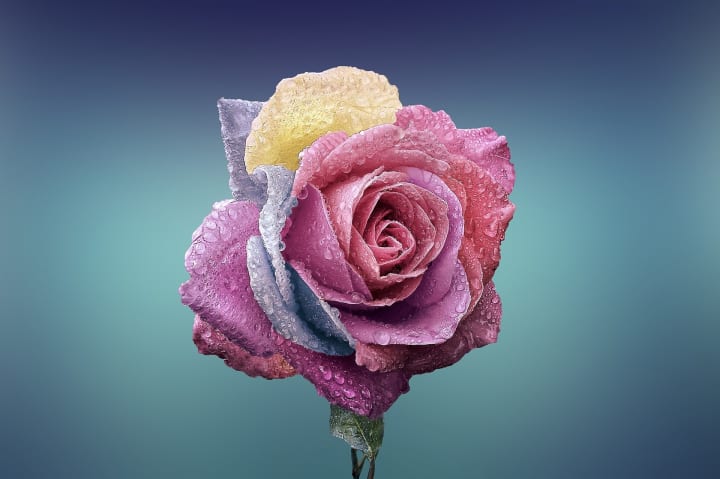How to Choose the Perfect Color for your Author Brand
Everyone knows color plays an important role in corporate branding and marketing for large companies. Over the years corporations have spawned iconic colors like Tiffany & Co.’s robin egg blue and T-Mobile’s magenta. The goal is to set a tone, attract customers, and get them in the right mindset.
Color branding is just as important for authors as it is for companies, and the same rules of marking apply. Your author brand can give you a serious edge when it comes to marketing and promoting your work. Choosing the right color for your brand helps you connect with an audience that is enthusiastic about your writing and unique perspective.
Color should be part of your marketing toolkit. Here’s how you can make the best of it as an author.
What is Color Theory?
Let’s get into the basics of color theory. Color theory offers some guidelines on how to use color for the best artistic and visual results. Chances are, you’ve seen a diagram of the color wheel. The wheel is helpful because it shows us how different colors relate to each other, and which ones look best together. You can also see the basic groupings of warm and cool colors.

- Primary colors red, blue, and yellow are classic and bold. These bright colors deliver a lot of visual impact, but they also have a simplicity to them.
- Secondary colors are green, orange, and purple. These colors make an impact and tend to carry more weight than primary colors, because they’re more unusual. They’re often used as accents in a brand or design.
- Tertiary colors are more complex and specific colors. Red-violet, blue-green, yellow-green, and other hues fall into this category. These colors tend to be more subtle and complex. They can give a more sophisticated feel to your branding.
Tints and Shades
Beyond the hues seen on the average color wheel, you have tints and shades:
- Tints are colors with white added; think of sky blue or pastel pink.
- Shades are colors with black mixed in, creating darker colors like midnight blue and deep purple.
These variations make a difference in the overall feeling, too. Let’s see some examples:

The sage green background behind this reading bunny gives an air of calmness. Overall, the tint has a clean and relaxed feel. The image is fairly cozy.

Contrast that pale sage green with the deep forest greens in this photo. Darker colors take on a more intense feel than lighter versions, in general. They give off a feel of excitement and the unexpected.
Color Combinations
Plenty of brands use full color schemes for their marketing, and not just single colors. Choosing this route gives you more to work with when creating brand imagery. If you want to put together a color scheme, consider these common ways to combine colors:
Complementary Colors
Complementary colors are located across each other on the color wheel, and this is where you get classic combinations like red and green. This creates an energetic, high-contrast look. It’s definitely an attention-getting style, but some might find it too over the top.

Analogous Colors
Analogous colors are groups of three colors right next to each other, and they create a subtle gradient. Purple, blue, and green form an analogous color scheme, and it can be soothing to look at colors that match up so nicely.

Monochromatic Colors
Monochromatic color schemes feature variations on one hue for a cohesive effect. It creates a simple and harmonious look. This option can be striking in its own way, but it may not work for someone whose brand needs more drama.

Adobe has a useful free online tool that makes it easy to experiment with any of these color combinations to create a 5-color palette. Another option is to try an online color scheme generator. There are dozens of options, but we recommend Coolors. With this app, you can generate color schemes at random, see trending palettes, and create your own using a specific image as your basis.
RGB vs. CMYK Color Mixing
There are two color modes you should be familiar with: RGB and CMYK:
- The RGB color mode should always be used for images that are going to be shown on a screen. It’s a light-based color mode that relies on the LEDs in a computer, TV, or phone screen. The LEDs combine different values of blue, red, and green light to create different colors. For the RGB color mode, each color is represented by a certain value for red, green, or blue. This is the additive color mixing method, and it’s suited specifically for screens because they use light to display images.
- CMYK is the best color mode for the domain of print. Printers create colors using cartridges of ink in cyan, yellow, magenta, and key. “Key” is printer jargon for the black ink cartridge, and it’s a holdover from traditional printing methods. This is the subtractive color mixing method, which applies to any paint, pigment, or ink mixing.
When images designed for RGB color mode are printed, they turn out looking dull and significantly different from the image on screen. CMYK designs look different on screens than they will when printed, too. That’s why it’s important to keep the purpose of your image in mind when you first design it.
What Can Color Do for Your Author Brand?
Consistency
Consistent branding is key to forming an audience and making sure people know where to find you. There’s no shortage of books, articles, and short stories to read. How can you stand out?
Using a key color is an easy way to maintain consistency in your brand over time. The benefit of color is that it’s instantly recognizable, and our brains can parse it even faster than they can read words. Cultural associations with colors run deep, and they can evoke emotions or help people make assumptions.
Brand consistency establishes who you are and what you do. What kind of writing should readers expect from you? Use of color is one indication of genre and content. If you keep a cohesive look across your website and other platforms, that’s one step toward establishing trust in your creative vision and writing style.
If you stick with a color scheme, your readers will learn to associate those colors with your work and author persona. It can even help them remember who you are. Our brains love associations, and the more you give them to work with, the better.
Recognizability
If you want people to instantly recognize your author brand, a smart use of color is a great way to get started. Most famous books and series tend to have recognizable covers and style. Whether you love them or hate them, you can recognize the books from the Twilight series immediately, thanks to the uniformity across their color branding: black and white covers with a red accent.
Color is sometimes easier to remember than a title or author name. In fact, librarians and booksellers get questions all the time asking for help finding books by color, because their patrons can’t remember much else about the book. It’s so common that one librarian wrote a guide on how to search for books by color.
If you want people to be able to pick your promotional images or even book covers out of a lineup, it definitely helps to have a go-to color.
Labeling
Labels are useful tools for marketing. As an author, you know how important genre is for getting readers interested. You can use color as an extension of the same principle.
Color branding can give people some idea of what to expect from your work. Colors have deep psychological and cultural associations, and you can make use of these to connect with the right potential readers. Color can help you establish the genre of your writing, too.
Books of investigative journalism like Catch and Kill, Bad Blood, and Black Hawk Down often have black covers, and that intense color tells readers to expect some equally intense content. All of those books also have red title text, signaling that violence or danger is involved.
What Message Does Your Color Send?
As an author, you’re probably familiar with color symbolism. Literature is full of color symbolism, from the famous green light in The Great Gatsby to Edgar Allan Poe’s horror story “Masque of the Red Death.”
We know that color sets an instant mood. The sickly yellow tones on the walls in the creepy short story “The Yellow Wallpaper” make us feel penned-in and fearful, just like the narrator. White can be used to make a setting feel cold and clinical, but it can also symbolize a safe, welcoming haven. Associations with color run deep, and you can use them to express your intentions to potential readers.
Color symbolism doesn’t stop at fiction. Companies use it as part of their branding technique all the time. Tech companies tend to choose blue to communicate trustworthiness. Green is a popular color for food companies, because it makes us think of freshness. You can use the same idea as an author, and connect with readers emotionally by using the right color.
Here are some of the feelings and moods commonly associated with colors:
- Black: elegance, power, formality, mourning.
- Brown: earthiness, tradition, practicality.
- White: minimalism, purity, mourning.
- Red: power, love, violence, danger.
- Orange: energetic, warmth, creativity.
- Yellow: happiness, wealth, cowardice.
- Green: nature, wealth, positivity, new growth.
- Blue: calming, security, spirituality.
- Purple: royalty, creativity, mysteriousness.
- Pink: youth, femininity, playfulness, modernness.
Some genres have colors associated with them already. Science fiction tends to use cool colors like deep blues, greens, purples, and metallic tones.

Romance novels, of course, are closely associated with reds and pinks, and light purple is becoming a popular choice.

If you don’t want to stick to convention, you can get creative with your choices. You can also experiment using shades and tints. Dark orange, for example, has a more severe feel than bright orange. It’s close to brown and has a similar earthiness. This shade of orange could work quite well for a drama or book dealing with history. Some romance novel covers are shifting away from tradition and embracing bright, upbeat colors, such as sunny yellow and cerulean blue.
How Do You Incorporate Color into Your Author Brand?
Once you choose a color, how do you use it? A good rule of thumb is to use your author color consistently across your website, marketing materials, and social media. Depending on how much control you have over your book covers, you can even find ways to incorporate the color on them. You can even showcase your brand color in some of your attire!
On Your Author Website
One of the benefits of creating an author website is that you’ll have complete control over the visuals and contents. On your website, you have the freedom to experiment with color and design.
It’s important to consider readability when designing your author website, so you might want to avoid bright colors for your background or text. There are plenty of other ways to incorporate your brand into your website, though.
The site header is always a good place to highlight your signature color, because it’s the first thing people see and is a major part of any website design. Bars and other accents are frequently included as part of the layout, and they’re another great place to add color without distracting from the content. Links or buttons can also be used as fun color accents.
On Social Media Posts
For many authors, social media is a place to find community and share writing projects with others. It’s also a good place to share promotional images for your work and any upcoming events. For example, if you have an upcoming reading, a Q&A session, or a giveaway, you can use your color branding to promote them.
Your user icon is another potential place to bring in color branding. Since this icon appears next to every post, it’s a good opportunity to create an association with a particular color.
Some people use backdrops for their social media posts. For example, a marble background for photos of brunch or new book purchases. Try finding a background that fits your chosen color scheme, so you can add a personal touch even to photo posts that aren’t strictly promotional. Fabrics and photo backdrops work well for this.
On Your Book Covers
Using the same color palettes can be key when branding a book series. But even if you are a stand alone kind of writer, remember colors produce instant mental associations. Stick to colors that represent your genre, tone, and author persona, unless you deliberately plan to subvert your readers’ expectations.
Also, you can smartly choose palettes that are friendly to your signature color, so you can use it in every single cover without being obvious. Even if it’s but a splash, the more your readers see your brand color, the more they will identify it with your work and author persona.
On Yourself
Your author and day-to-day personas are not the same. In a sense, your author persona is a character, one that helps you sell, well, yourself! That doesn’t mean you should be fake or distant when interacting with your readers, quite the opposite. It means that you need to be more aware of how your overall presence is impacting your audience.
Next time you’re in front your closet, pondering what to wear to a writer’s convention, panel, or readers event, consider adding a detail in your attire that showcases your brand color. You can be as bold or as subtle as you want. Fashion and style are powerful weapons when building a unique author look!
Choosing a signature color is essential when building a strong, memorable author brand—never pick it willy-nilly! Take your time to figure out which color would best represent both your books and your author persona. Look for inspiration in heavily branded content, such as product packaging, movie posters, billboards, and book covers. Check out the looks of authors you enjoy and try to find out if they have a signature color and how it helps define their image and work. Experiment, have fun, and color your world!